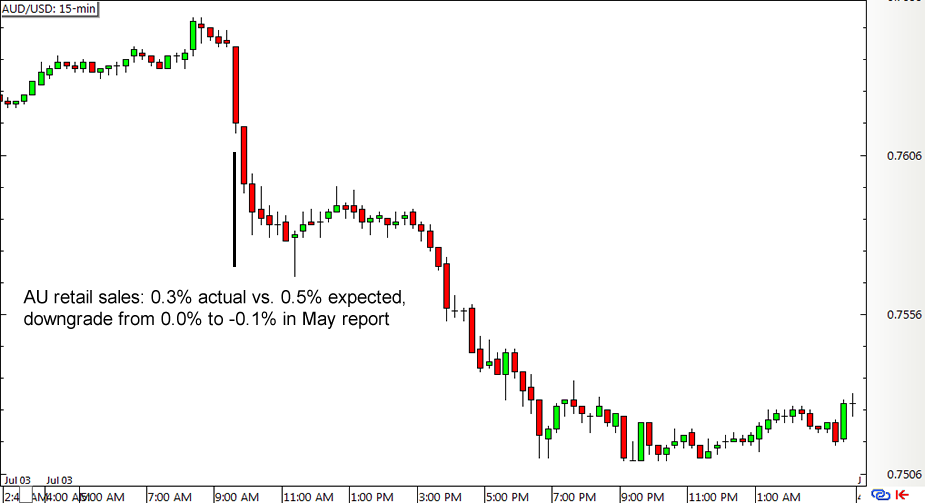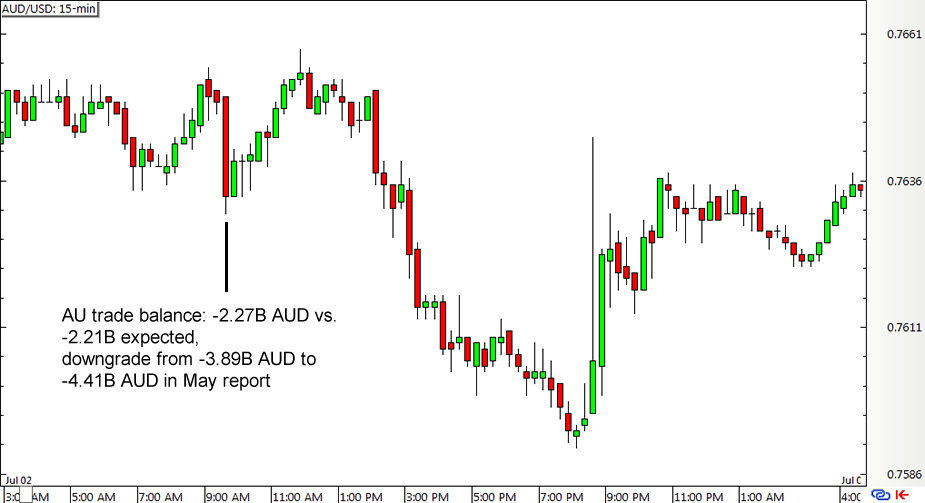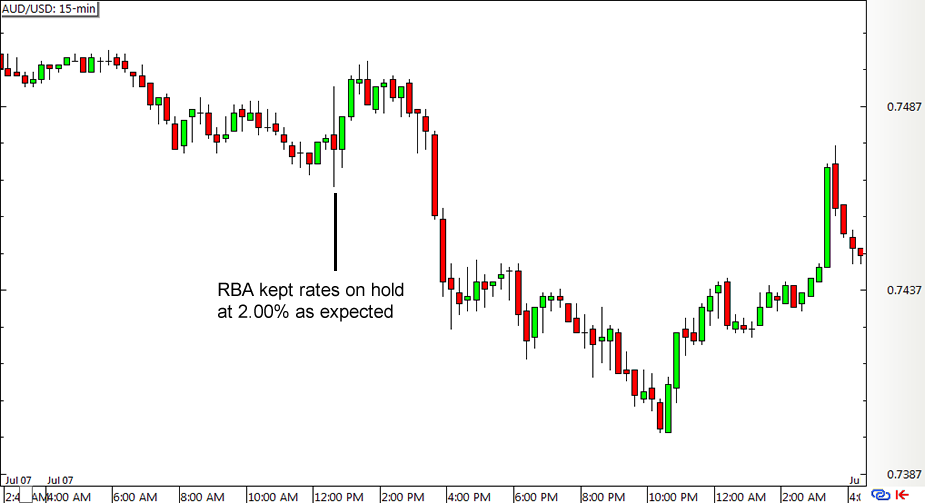G’day, mates! If you’re hoping to catch some waves on the Aussie forex pairs this week, then you definitely gotta take a look at these top-tier catalysts on the lineup. We’ve got FIVE major economic events in the Land Down Under, which means five opportunities to take advantage of the additional volatility to grab some pips.
1. Retail Sales (Tues, 1:30 am GMT)
The fun starts on Tuesday when Australia prints its retail sales report for the month of June. Analysts are expecting to see a 0.5% increase in consumer spending, higher than the previous month’s 0.3% uptick.
Keep in mind, however, that the retail sales report has been churning out weaker than expected results for the past three releases and that two of those even suffered downward revisions later on. With that, there could be a good chance of seeing another downside surprise this time, which might spur Aussie weakness.
Here’s how AUD/USD reacted during the release of the May retail sales report:
2. Trade Balance (Tues, 1:30 am GMT)
Australia is set to release its trade balance at the same time as its retail sales report on Tuesday, which suggests that the Aussie’s forex reaction could either be magnified or be limited depending on the results. For the month of June, the trade deficit is expected to have widened from 2.75 billion AUD to 3.06 billion AUD, reflecting weaker export activity.
The past three releases have come in below expectations, with a couple of reports undergoing negative revisions and one enjoying a small upgrade. This suggests that the odds are also tilted to the downside for this one, possibly putting more weight on the Australian currency.
Here’s how AUD/USD reacted to the May trade balance report:
3. RBA Interest Rate Decision (Tues, 4:30 am GMT)
Perhaps the biggest event for the Aussie this week is the central bank’s interest rate decision, which is also scheduled on Tuesday. Most market watchers are still expecting RBA Governor Stevens and his gang of policymakers to keep rates on hold at 2.00% for the time being.
Take note that the RBA has already cut interest rates in two instances so far this year so it’s likely that policymakers will continue to sit on their hands and assess the impact of their latest easing efforts. However, the outlook for the Australian economy ain’t looking too good at the moment due to the slowdown in China and another potential drop in commodity prices, which means that a dovish announcement is a possibility.
In their June rate statement, the RBA mentioned that economic growth has been below its long-term average and that unemployment remains elevated but refrained from giving an explicit easing bias.
4. Employment Report (Thurs, 1:30 am GMT)
On Thursday, Australia will release its June jobs report and probably show a 12.5K rise in hiring, a faster pace of increase compared to May’s 7.3K figure. Meanwhile, the unemployment rate is expected to climb from 6.0% to 6.1%.
Three out of the last four releases have beaten market expectations, but the last two ones were downgraded later on, suggesting that the Australian Bureau of Statistics’ labor market estimates should be taken with a grain of salt. That’s probably why AUD/USD typically has a short-lived initial reaction to the report then stages a reversal in the latter sessions.
5. RBA Statement on Monetary Policy (Fri, 1:30 am GMT)
Last but definitely not least is the RBA’s official statement on monetary policy, which is different from the central bank’s interest rate announcement. This report is released on a quarterly basis and contains more deets on the economic and financial factors that influenced the policymakers’ decisions and biases.
The earlier release back in May 8 suggested that the central bank is prepared to lower interest rates again if necessary. Policymakers also cut their growth forecasts for the next couple of years, citing the delay in the recovery of non-mining investment as one of the main reasons for the downgrades.
The upcoming release could feature more downbeat remarks, as central bank officials could factor in the recent stock market tumble in China plus further declines in iron ore prices and exports. But if RBA officials shrug off these headwinds and try to restore confidence in the Australian economy, the Aussie might still be able to stay supported in the long run.
Recommended Content
Editors’ Picks
USD/JPY holds above 155.50 ahead of BoJ policy announcement

USD/JPY is trading tightly above 155.50, off multi-year highs ahead of the BoJ policy announcement. The Yen draws support from higher Japanese bond yields even as the Tokyo CPI inflation cooled more than expected.
AUD/USD consolidates gains above 0.6500 after Australian PPI data

AUD/USD is consolidating gains above 0.6500 in Asian trading on Friday. The pair capitalizes on an annual increase in Australian PPI data. Meanwhile, a softer US Dollar and improving market mood also underpin the Aussie ahead of the US PCE inflation data.
Gold price keeps its range around $2,330, awaits US PCE data

Gold price is consolidating Thursday's rebound early Friday. Gold price jumped after US GDP figures for the first quarter of 2024 missed estimates, increasing speculation that the Fed could lower borrowing costs. Focus shifts to US PCE inflation on Friday.
Stripe looks to bring back crypto payments as stablecoin market cap hits all-time high

Stripe announced on Thursday that it would add support for USDC stablecoin, as the stablecoin market exploded in March, according to reports by Cryptocompare.
US economy: Slower growth with stronger inflation

The US Dollar strengthened, and stocks fell after statistical data from the US. The focus was on the preliminary estimate of GDP for the first quarter. Annualised quarterly growth came in at just 1.6%, down from the 2.5% and 3.4% previously forecast.



